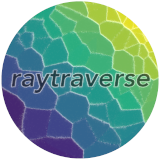Source code for raytraverse.sampler.draw
# -*- coding: utf-8 -*-
# Copyright (c) 2020 Stephen Wasilewski, HSLU and EPFL
# =======================================================================
# This Source Code Form is subject to the terms of the Mozilla Public
# License, v. 2.0. If a copy of the MPL was not distributed with this
# file, You can obtain one at http://mozilla.org/MPL/2.0/.
# =======================================================================
"""wavelet and associated probability functions."""
import numpy as np
from craytraverse.craytraverse import from_pdf as c_from_pdf
from scipy.ndimage import convolve
[docs]
def get_detail(data, *args, mode='reflect', cval=0.0):
"""convolve a set of kernels with data. computes the sum of the
absolute values of each convolution.
Parameters
----------
data: np.array
source data (atleast 2D), detail calculated over last 2D
args: np.array
filters
mode: str
signal extension mode (passed to scipy.ndimage.convolve)
cval: float
constant value (passed to scipy.ndimage.convolve, used when
mode='constant')
Returns
-------
detail_array: np.array
1d array of detail coefficients (row major order) matching
size of data
"""
d_det = []
s = data.reshape(-1, *data.shape[-2:])
for d in s:
ds = np.zeros_like(d)
for f in args:
ds += np.abs(convolve(d, f, mode=mode, cval=cval))
d_det.append(ds.ravel())
return np.concatenate(d_det)
[docs]
def from_pdf(pdf, threshold, lb=.5, ub=4, minsamp=0):
"""generate choices from a numeric probability distribution
Parameters
----------
pdf: np.array
1-d array of weights
threshold: float
the threshold used to determine the number of choices to draw given
by pdf > threshold
lb: float, optional
values below threshold * lb will be excluded from candidates
(lb must be in (0,1)
ub: float, optional
the maximum weight is set to ub*threshold, meaning all values in pdf
>= to ub*threshold have an equal chance of being selected.
in cases where extreme values are much higher than moderate values,
but 100% sampling of extreme areas should be avoided, this value should
be lower, such as when a region is sampled at a very high resolution (
as is the case with directional sampling). On the other hand, set this
value higher for sampling schemes with a low final resolution (like
area sampling). If ub <= 1, then a deterministic choice is made,
returning the idx of all values in pdf > threshold.
Returns
-------
idx: np.array
an index array of choices, size varies.
"""
# bypass random sampling
if ub <= 1:
idx = np.argwhere(pdf > threshold).ravel()
if idx.size < minsamp:
idx = np.array([0])
return idx
pdf[pdf > ub*threshold] = ub*threshold
candidates, bidx, nsampc = c_from_pdf(pdf, threshold, lb=lb, ub=ub+1)
nsampc = max(nsampc, minsamp)
if nsampc == 0:
return bidx
# if normalization happens in c-func floating point precision does not
# guarantee that pdfc adds to 1, which choice() requires.
nperr = np.seterr(all="raise")
try:
pdfc = pdf[candidates]/np.sum(pdf[candidates])
if candidates.size == 0:
raise ValueError
except (FloatingPointError, ValueError):
cidx = np.random.default_rng().integers(pdf.size, size=nsampc)
else:
cidx = np.random.default_rng().choice(candidates, nsampc,
replace=False, p=pdfc)
np.seterr(**nperr)
return np.concatenate((bidx, cidx))
